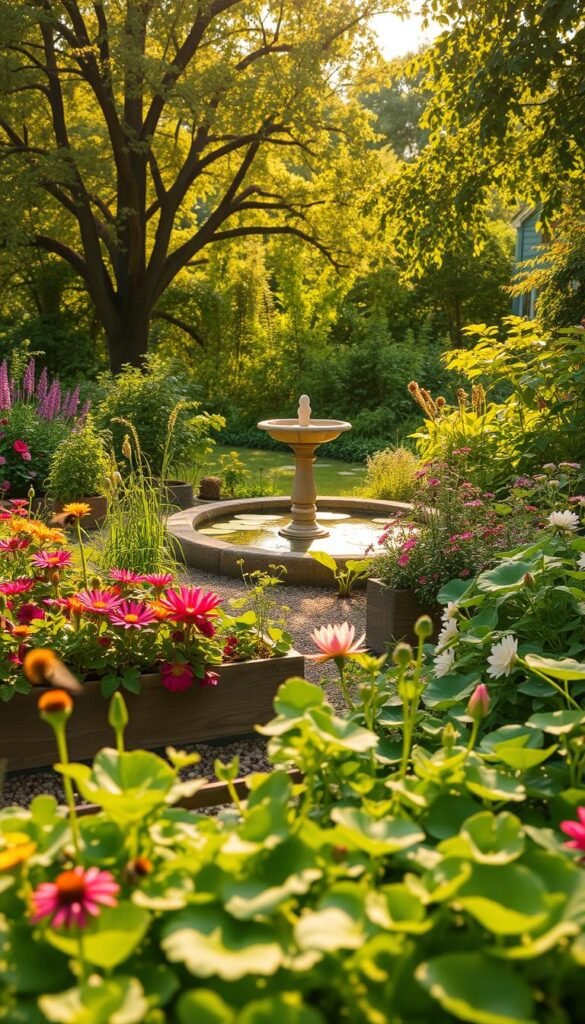Transforming your outdoor space into a vibrant, earth-friendly haven starts with simple choices. By working with nature rather than against it, you can grow lush, productive areas that benefit both your household and local wildlife. This approach focuses on natural cycles, reducing waste, and fostering biodiversity—all while yielding fresh herbs, fruits, and vegetables.
Mindful gardening practices prioritize native species and organic methods, creating habitats where bees, butterflies, and birds thrive. At places like Elk Root Conservation’s farm in British Columbia, these principles demonstrate how sustainable techniques build resilient food systems. Your efforts can mirror this by avoiding synthetic chemicals and embracing compost-rich soil.
Every plant you choose plays a role in supporting your region’s delicate balance. Drought-resistant varieties, for example, reduce reliance on irrigation while attracting pollinators. Over time, these decisions create self-sustaining spaces that adapt to climate shifts and require less upkeep.
You’ll discover that nurturing such an environment isn’t just about growing food—it’s about cultivating a deeper connection to the land. The result? A lively retreat that nourishes your family, protects local ecosystems, and leaves a lighter footprint on the planet.
Understanding the Principles of Eco-Gardening
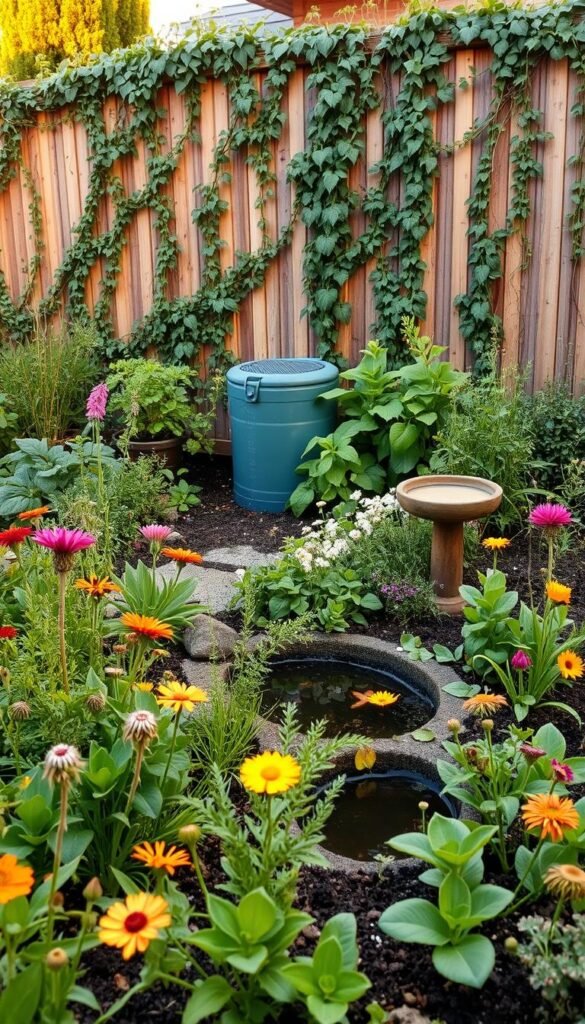
Embracing nature’s wisdom can turn any plot into a resilient ecosystem. This method prioritizes harmony with local conditions, using strategies that strengthen soil, save water, and invite wildlife. Instead of battling pests or climate challenges, you’ll collaborate with natural patterns to grow vibrant spaces.
What Is Eco-Gardening?
This approach replaces synthetic chemicals with organic alternatives, focusing on long-term soil health. By choosing native plants, you reduce the need for extra watering or fertilizers. These species already thrive in your region’s climate, making them low-maintenance allies. For example, native plant gardening supports pollinators while requiring fewer resources.
The Benefits of Sustainable Gardening Practices
Healthier soil means stronger roots and fewer pests. Composting kitchen scraps or leaves feeds microorganisms, creating a self-sustaining environment. Over time, these practices cut maintenance costs and protect nearby waterways from runoff pollution.
You’ll also notice more birds and bees visiting your space. Diverse plantings create habitats, boosting local biodiversity. Even small changes—like leaving fallen leaves as mulch—make a measurable difference for your ecosystem.
Cultivating Organic Practices for a Thriving Garden
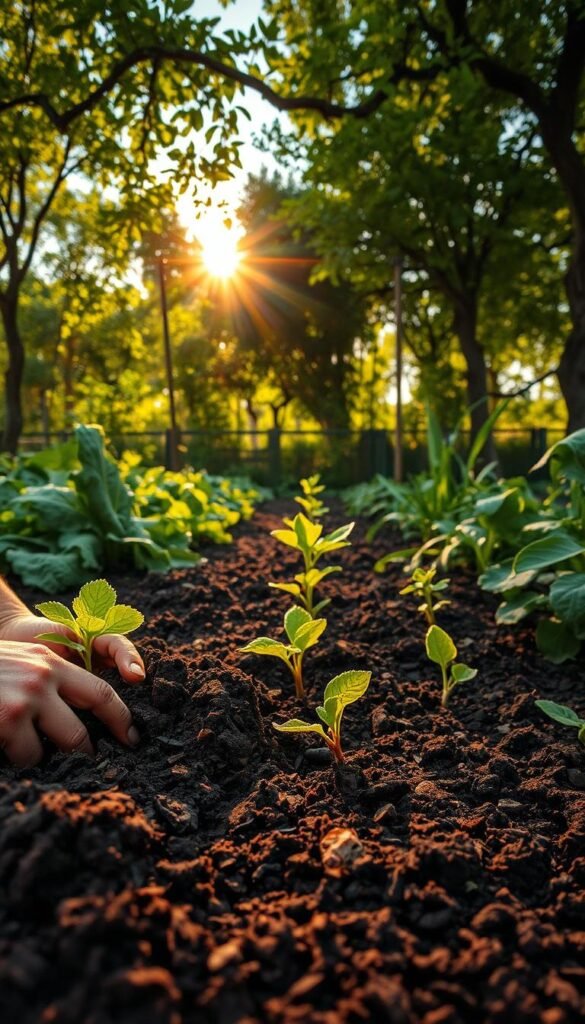
The secret to a lush garden isn’t just what you plant—it’s how you feed the ground they grow in. Organic methods focus on creating living soil that sustains your plants while eliminating harmful chemicals. This approach mimics nature’s recycling system, turning waste into resources your garden craves.
Techniques for Building Healthier Soil
Certified growers boost soil fertility using layered methods like lasagna gardening. Alternate carbon-rich materials (wood chips) with nitrogen sources (grass clippings) to create slow-release nutrients. These layers suppress weeds while inviting earthworms and microbes to work their magic.
Cover crops like clover add nitrogen naturally during fallow periods. As they decompose, they leave behind organic matter that improves soil structure. Rotating crops annually prevents nutrient depletion and disrupts pest cycles.
Embracing Composting and Natural Mulches
Turn kitchen scraps into black gold through composting. A balanced mix of greens (vegetable peels) and browns (dry leaves) creates heat that breaks down waste faster. This free fertilizer feeds your plants while reducing landfill contributions—a win for your garden and the planet.
Living mulches like creeping thyme offer dual benefits. They protect soil from erosion while releasing antifungal compounds. For best results, pair them with organic gardening basics like proper watering schedules and native plant selections.
These practices create a self-renewing system. Healthy soil grows robust plants, whose fallen leaves and spent blooms feed the next generation of crops. Over time, you’ll spend less on amendments while harvesting more nutrient-dense food.
Eco Garden Essentials: Water Conservation, Pollinators, and Beyond
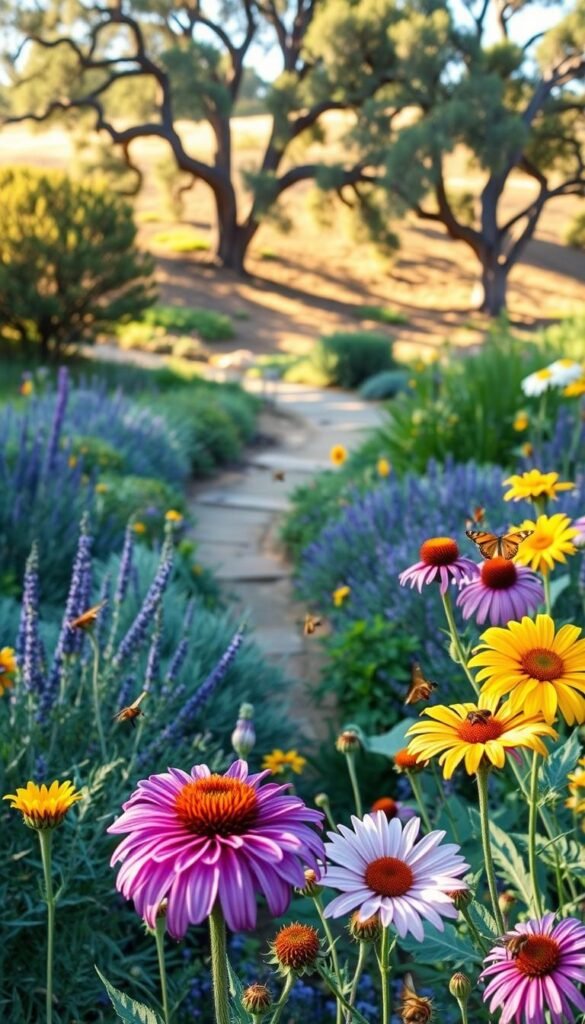
What if your efforts to save water could also create a sanctuary for bees and butterflies? Merging these two goals creates landscapes that thrive with minimal intervention while supporting local ecosystems.
Key Steps to Integrate Water Conservation and Pollinator Support
Start by choosing drought-tolerant vegetables like okra or herbs such as lavender. These plants need less moisture but still offer nectar-rich blooms. Pair them with native wildflowers that bloom at different times, ensuring pollinators find food all season.
Upgrade your watering system with drip lines and timers. Setting irrigation to run at dawn prevents evaporation loss. This precision keeps soil consistently moist for pollinators’ favorite flowers without wasting water.
Collect rainfall using barrels or build a plastic-free pond like Elk Root Conservation’s model. Their design uses local clay and stones to create drinking spots for turtles and dragonflies. These features double as habitat hubs while cutting your water bill.
By aligning permaculture design principles with wildlife needs, you’ll build a resilient space. Shallow puddling areas near flowering shrubs give butterflies hydration, while deep-rooted plants stabilize soil during heavy rains. This layered approach maximizes biodiversity while making every drop count.
Integrating Water-Wise Techniques in Your Garden
Smart hydration strategies can transform how your green space thrives while protecting local ecosystems. Let’s explore methods that keep roots quenched without draining resources.
Efficient Irrigation Strategies to Conserve Water
Drip systems deliver moisture straight to roots through tubes with tiny holes. Pair them with timers to water during cooler hours—evaporation drops by 30% compared to midday sprinklers. One Elk Root Conservation team member notes:
“Timed drip lines reduced our farm’s usage by 40% last summer while boosting tomato yields.”
Soaker hoses work well for rows of plants. They release water slowly, letting soil absorb every drop. Check connections monthly to prevent leaks that waste precious resources.
Rainwater Harvesting and Sustainable Water Use
Start small with a barrel under your backyard downspout. A single storm can fill it enough to hydrate veggies for weeks. For larger needs, consider a clay-lined pond like ERC’s new design:
| Feature | Barrel | Catchment Pond |
|---|---|---|
| Capacity | 50-80 gallons | 500+ gallons |
| Wildlife Support | Minimal | Hosts turtles, dragonflies |
| Installation Time | 1 hour | 2-3 days |
Mulch beds with straw or wood chips to lock in moisture. This simple step cuts watering time by half during heatwaves. Combine these approaches to create a self-sufficient system that thrives in dry spells.
Attracting and Nurturing Beneficial Insects
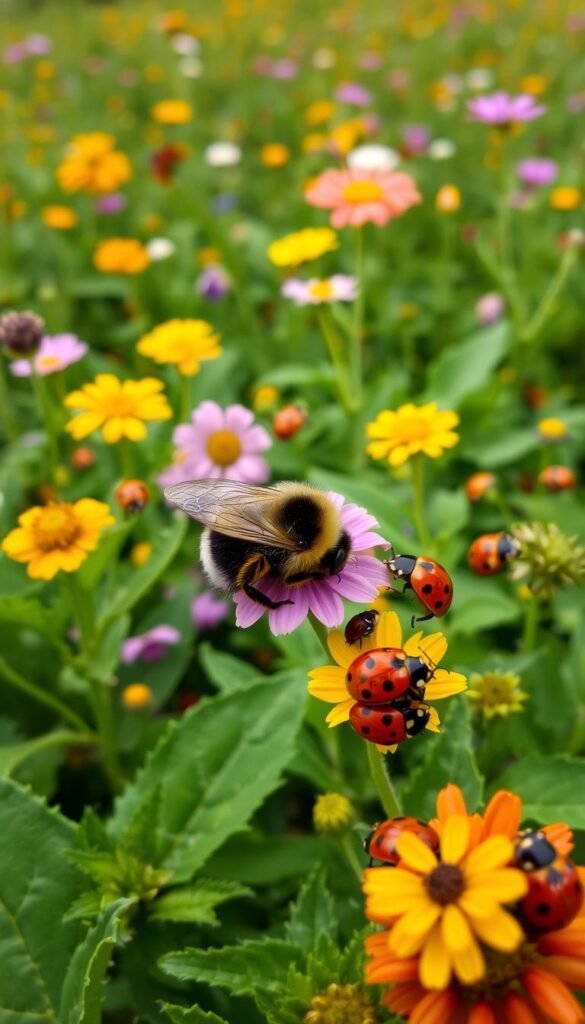
Inviting helpful bugs into your space creates a living pest control system. These tiny allies pollinate crops, devour harmful larvae, and improve soil health—all while reducing your workload. Focus on flowers and strategic layouts to build habitats where beneficial insects thrive naturally.
Pollinator Companion Planting Approaches
Pair vegetables with edible blooms like calendula or borage. These plants attract hoverflies that eat aphids while providing nectar. The essential guide to cultivating a thriving pollinator recommends seed mixes like West Coast Seeds’ Pollinator Companions Pack. It combines cherry tomatoes with chamomile—offering food for you and pollen for bees.
Creating Bee-Friendly and Insect-Supportive Areas
Design zones with staggered bloom times. Early spring crocuses feed emerging queen bumblebees, while autumn asters sustain late-season workers. Leave some herbs unharvested—their flowers become pit stops for solitary insects.
Leveraging Beneficial Predatory Insects
Welcome wasps by planting eryngium. At Elk Root, these spiky blooms distract predators from hives while they hunt cabbage moths. Avoid sprays—they kill helpful species like ladybugs. Instead, let nature’s hunters manage pests while you enjoy healthier garden yields.
Designing with Native and Host Plants for Biodiversity
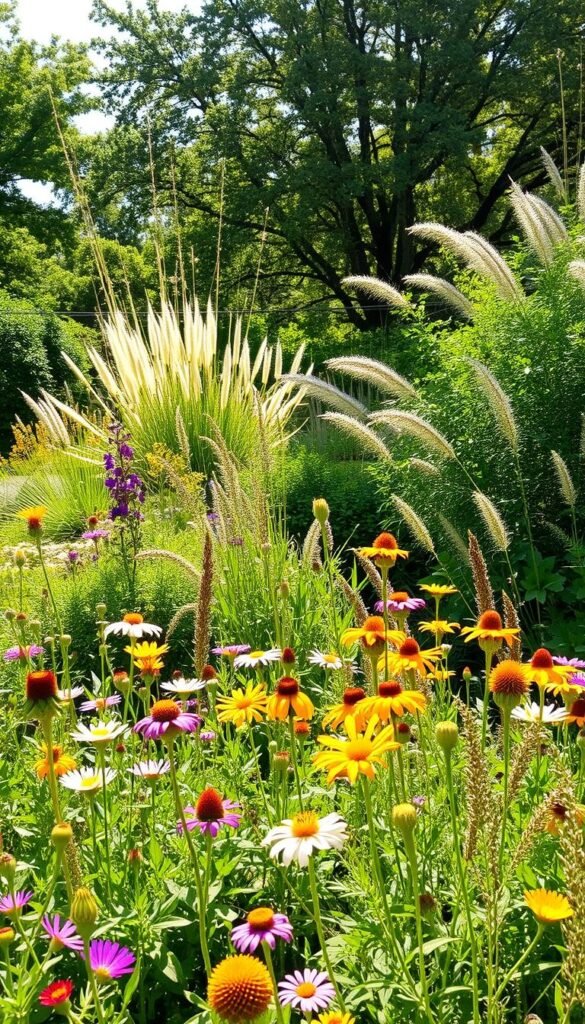
Your landscape choices can become lifelines for local ecosystems when you focus on region-specific flora. True native plants differ from generic wildflowers—they’ve evolved over millennia alongside local wildlife, forming irreplaceable partnerships. For instance, monarch butterflies only lay eggs on milkweed, while goldenrod fuels fall migrations for countless pollinators.
Selecting the Right Native Plants
Start by identifying species that naturally thrive in your area’s soil and climate. Contact local nurseries or extension offices for plants grown from regional seeds—these “local ecotypes” handle droughts better than store-bought alternatives. As one Virginia Master Naturalist notes:
“Our purple coneflowers survived last summer’s heatwave without watering, while non-natives wilted within days.”
Prioritize multi-purpose varieties like bee balm, which offers nectar for hummingbirds and leaves for herbal tea. For structured guidance, explore pollinator-friendly garden designs that balance beauty and ecological function.
Understanding the Role of Host Plants
These unsung heroes provide nurseries for insects’ early life stages. Black-eyed Susans feed adult bees, but their leaves also host crescent butterfly larvae. Create zones where 30% of your plants serve as caterpillar food sources—this sustains pollinators year-round.
| Nectar Plants | Host Plants | Wildlife Supported |
|---|---|---|
| Coneflowers | Milkweed | Monarch butterflies |
| Goldenrod | Parsley | Swallowtail caterpillars |
| Bee Balm | Oak trees | 500+ moth species |
By mixing these roles, you’ll build habitats that support entire lifecycles. Even small patches of native host plants make neighborhoods friendlier for pollinator-haven creatures like ladybugs and lacewings. Over time, these choices create self-sustaining spaces where nature handles pest control and soil enrichment.
Creative Garden Design for Seasonal Success
Your outdoor space can dazzle year-round with smart planning that works with nature’s calendar. Focus on layering colors, textures, and bloom times to create visual interest through every season. Small adjustments to your layout and plant choices keep the space lively even as temperatures shift.
Planning for Vibrant Spring Blooms and Rich Fall Foliage
Start spring with early risers like crocuses and daffodils. Pair them with summer stars such as coneflowers and black-eyed Susans for nonstop color. As autumn approaches, swap fading annuals with chrysanthemums or ornamental kale. These plants thrive in cooler weather while adding fiery reds and purples.
Adapting Your Garden to Local Climate Variations
Choose species that match your area’s rainfall and temperature patterns. In dry regions, opt for succulents or lavender in container setups for easy relocation. Coastal zones? Salt-tolerant grasses and sea thrift handle windy conditions. Observe how sunlight moves across your garden through the year—place shade-loving ferns under deciduous trees that lose leaves in winter.
Rotate flowers seasonally to keep the design fresh. For example, replace spring tulips with heat-loving zinnias. This approach maximizes your space’s potential while giving each plant its moment to shine. With thoughtful timing, you’ll enjoy a dynamic landscape that celebrates every phase of nature’s cycle.

